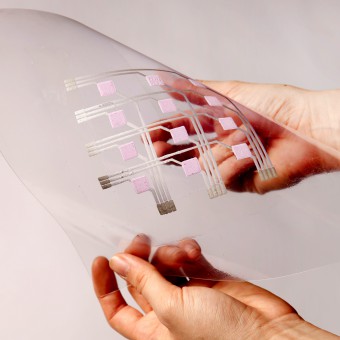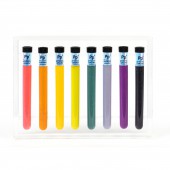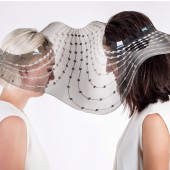TechniChrome Paintable Digital Display by Carolyn Tam |
Home > Winners > #69884 |
 |
|
||||
| DESIGN DETAILS | |||||
| DESIGN NAME: TechniChrome PRIMARY FUNCTION: Paintable Digital Display INSPIRATION: Typically, digital displays such as LED screens or E-ink require complex manufacturing process. They are pre-designed and come in a fixed size frame which limits where users can show digital information. Another limitation for current display technology is that it is hard to achieve on the curve or flexible surface. Even though at the moment there are displays such as flexible OLED displays, such technologies are complex and very expensive. UNIQUE PROPERTIES / PROJECT DESCRIPTION: TechniChrome disrupts the way we present digital information by making them paintable and can applied to many surfaces. Using a combination of smart materials, users can paint displays onto things like walls, furniture, or any other surfaces they can think of. The displays can be painted in any shape, inviting more creative and novel configurations. The high flexibility of the material allow displays to be folded and formed into any shape. One interesting use of TechniChrome display is to connect it to a microcontroller (ie. Arduino). This allow realtime data such as twitter status displays on analog objects. OPERATION / FLOW / INTERACTION: The TechniChrome paint can be accessed via tool kits, which allow people to experiment and prototype their own vision of the paintable display. TechniChrome could be used in advertising, or other creative purpose. TechniChrome displays can also be connected to a microcontroller, allowing for realtime data display on analog objects. With Technichrome, digital information will no longer constrained by rigid rectangular frames, enhancing our experience in the analog world. PROJECT DURATION AND LOCATION: The project start in Jan 2018 - Jun 2018 at Imperial College London. The project is also featured at Imperial News. Link here: https://www.imperial.ac.uk/news/187073/algae-purif iers-printable-pixels-students-designing/ |
PRODUCTION / REALIZATION TECHNOLOGY: This technology is achieved by using 2 types of smart materials. The main component is the pixel paint that I developed at Imperial College London. When electricity runs through the pixel paint, it will change colour from one to another (see video). The colour changing effect is a bit like the e-ink display. Another component for the TechniChrome display is silver conductive ink. The silver conductive ink acts as a paintable wire and complete the circuit. Since all the components are in a form of paint, users can make their own displays easily by painting them on any surfaces they can think of. SPECIFICATIONS / TECHNICAL PROPERTIES: The paintable display is achieved by using two main types of smart materials. 1- Pixel paint is a smart material that change colour when electricity current runs through it. This is a material I developed at the Imperial College London. 2- Conductive ink that acts as a paintable wire to complete the electric circuit. TAGS: Smart material, digital display, technology, innovation, paintable display RESEARCH ABSTRACT: The design development mainly focuses on developing and enhancing the performance of the paintable digital display. To optimise the performance of the pixel paint, I have to develop my own carbon ink. This allows user to run a TechniChrome display in a much lower power range. This hugely reduce the energy consumption, and increase the accessibility of the display. My latest testing shows that a 8x8mm pixel requires 0.006W of energy, which is 3 times less than a standard LED. Another technical issue is the refresh rate of the colour changing effect. Initially, a pixel paint requires 60 second to change from one colour to another. Throughout the project I keep improving the recipe of pixel paint. The latest result improve the refresh rate to 8-10 second. CHALLENGE: Typically, smart materials are not wide spread in the design arena because in general they are difficult to use. Even if designers know how to use these smart composites, there is a blurry line over what they can be used for. This restrict the widespread replacement of traditional materials with smart composites. One of the main challenge of my project is overcome these barriers, by designing a simplified process to help people to use and apply smart materials. I thought if I did this along with some new applications it would attract more users to engage with them. ADDED DATE: 2018-07-19 05:32:56 TEAM MEMBERS (1) : IMAGE CREDITS: Carolyn Tam, 2018. PATENTS/COPYRIGHTS: Patent pending |
||||
| Visit the following page to learn more: http://www.tamchiyan.com/portfolio-item/ |
|||||
| AWARD DETAILS | |
 |
Technichrome Paintable Digital Display by Carolyn Tam is Winner in Design Quality and Innovation Category, 2018 - 2019.· Read the interview with designer Carolyn Tam for design TechniChrome here.· Press Members: Login or Register to request an exclusive interview with Carolyn Tam. · Click here to register inorder to view the profile and other works by Carolyn Tam. |
| SOCIAL |
| + Add to Likes / Favorites | Send to My Email | Comment | Testimonials | View Press-Release | Press Kit |
Did you like Carolyn Tam's Design Quality?
You will most likely enjoy other award winning design quality as well.
Click here to view more Award Winning Design Quality.








